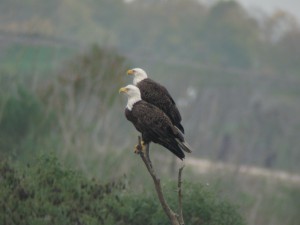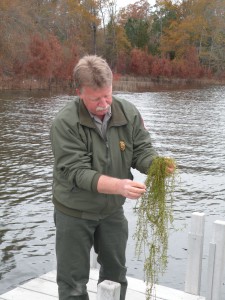Its origin is mysterious. Its prevalence ubiquitous.

Bald eagles perch at the U.S. Army Corps of Engineers J. Strom Thurmond Lake. USACE photo, December 2009.
The growing and invasive waterweed known as hydrilla beckons hungry waterfowl, known as coots, who fall prey to a lethal blue-green algae present on its leaves. The American bald eagles that prey on the coots, themselves become prey to the algae.
Monecious hydrilla, the reservoir’s dominant aquatic plant, provides a substrate for algae carrying a toxin and also happens to be an irresistible food source for coots. The toxin is linked to a lethal neurological disease called avian vacuolar myelinopathy (AVM).
Coots contracting AVM develop microscopic brain lesions crippling their movements rendering them easy prey for bald eagles, said Jeff Brooks, a Corps of Engineers wildlife biologist.
Officials first discovered hydrilla at the reservoir in 1995. In 1998, AVM claimed its first bald eagle. Since that time, 80 bald eagle deaths (29 confirmed from AVM) have occurred in the Thurmond area with four mortalities recorded this past winter, said Brooks.
“AVM cases peak November through February when blue-green algae becomes toxic,” said Brooks. “But it’s unclear what triggers the toxin as the seasons change.”

Army Corps of Engineers biologist Ken Boyd examines a strand of hydrilla, an invasive aquatic weed first discovered at Thurmond Lake in 1995. The plant harbors an algae linked to deaths of bald eagles at the reservoir. Photo by Rob Pavey (Augusta Chronicle), used with permission.
In October 2010, a survey conducted by the Corps, with assistance from the Georgia and South Carolina Departments of Natural Resources, reported that hydrilla occurs at varying densities on approximately 11,200 acres of Thurmond’s 71,000 acres. A separate survey to determine densities indicated that the average hydrilla density is 44 percent resulting in a total biomass estimate of 4,959 acres.
Hydrilla typically flourishes in shallow waters (20 feet or less) and can provide good habitat for some fish and waterfowl species. Over the years, the U.S. Army Corps of Engineers has used herbicides to minimize the impacts of hydrilla according to its Aquatic Plant Management Plan.
Herbicide treatments temporarily control its growth in high-use areas such as boat ramps or swim beaches, but AVM-related eagle mortalities have prompted efforts to consider widespread and long-term treatment alternatives, said Brooks.
The Corps partners with federal and state agencies to evaluate biological, mechanical and chemical treatments that are cost-effective and ecologically-sound, said Brooks.
Following the results of a 2013 survey, distributed to approximately 3,000 stakeholders designed to gauge sentiment on hydrilla issues and potential treatments, Corps officials sent a letter to the U.S. Fish and Wildlife Service and the Georgia and South Carolina DNRs requesting their concurrence with an integrated plan using sterile grass carp and herbicide to control hydrilla.
Survey results found that 74.3 percent of respondents were indifferent or in support of stocking sterile grass carp – the most controversial treatment method. Even more respondents, 84.5 percent, say they prefer less hydrilla or only native plants.
“With herbicide and algaecide we know where to apply it and what the impacts are,” said Brooks. “If carp are stocked, aquatic vegetation including native plants would be consumed. We’re also in the process of completing an updated hydrilla survey to get a better handle on total hydrilla coverage.”
But Brooks warns that any alternative can potentially carry adverse impacts.
“Although stocked grass carp would require testing to determine that they are [infertile], there’s an outside chance that fertile carp could be released,” he said. “On the other hand, some herbicides can create problems for macroinvertebrates such as aquatic insects or crayfish and annual applications would be more costly than carp.”
An Environmental Assessment (EA) is underway to evaluate treatment alternatives and potential impacts to the resource. The USFWS and Georgia and South Carolina DNRs have offered technical assistance, while Georgia DNR wanted the additional details regarding treatments and potential impacts further evaluated through the EA process, said Brooks.
Corps Avian Specialist Ellie Covington helms the EA/AVM management plan and said a draft is scheduled for the end of June. The final assessment and Finding of No Significant Impact is due spring 2016.
In April 2015, UGA researchers attached transmitters to three bald eagle nestlings to determine if birds remain onsite and develop AVM or fly offsite to another location. They also sought funding from the U.S. Fish and Wildlife Service for an experimental stocking of grass carp that would allow a telemetry study on carp movement in several coves at the lake.
“We’d like a consensus with state agencies on treatment alternatives because they’re involved with managing these resources as well,” said Brooks.
According to a report by Georgia Outdoor News, Georgia DNR representatives documented 166 successful bald eagle nests in 2015, a record for the state.
Since their removal from the endangered species list in 2007, eagle populations continue to thrive nationally. Although AVM threatens bald eagles on or near Thurmond waters, it’s largely a local issue isolated to Thurmond and has affected several other lakes throughout the southeastern U.S., including DeGray Lake in Arkansas, which recorded the first confirmed AVM eagle death in 1994.
~ Chelsea Smith, Public Affairs Specialist



So far, Thurmond has not experienced a human death associated with hydrilla. Not so for Georgia or other states.
Several years ago at Lake Spivey near Atlanta, Henri-Christophe Bourget went into the water
to retrieve a friend’s basketball, became entangled in the hydrilla, was pulled
underwater and drowned. Divers could not find Henri-Christophe because the hydrilla
was so dense. The lake had to be drained to find the teenager’s body.
Texas has had two hydrilla related drownings. The Texas DNR made the
decision to start using grass carp. A spokesman for the Texas DNR stated that safety
and property value considerations far exceeded any benefits from hydrilla.
The
Georgia DNR and Corps of Engineers have approved the use of grass carp at the Walter F. George
reservoir in southwest Georgia to control the hydrilla and the results have been
good. Walter F. George was completely choked by hydrilla before the decision was
finally made.
The hydrilla in Thurmond can be easily spread to any body of water in Georgia by
boat or boat trailer or by geese and ducks who eat the hydrilla and then poop the
hydrilla turion (seed) where ever they fly. Every lake, farm pond, river and creek
in Georgia is at risk.
Right now the only permitted way to fight hydrilla is with Komeen, K-tea or Reward.
Very expensive. Look up these Material Safety Data Sheets (MSDS) and decide for
yourself if you want these chemicals in our shared drinking water or in the water
where our children play.
Clayton County officials put grass carp in Lake Spivey the day after UGA made that
recommendation. Jean-Claude and Miyoshi Bourget, Henri-Christophe’s parents, take
little comfort in this.
Yu nah ee tah, you make some great arguments! I also encourage implementing the next level of human intervention rather than continuing to let nature take its course. I think the priority should be developing an environmentally responsible plan to introduce grass carp into Thurmond for primary control rather settling for the more cost efficient spraying. Human safety and boating access remain important considerations, and we already release too many toxic chemicals into our water supplies. I share the topic concern about inadvertent release of fertile carp because of the large numbers that will be required initially and over time, but additional testing could help alleviate that concern. I accept the need to evaluate the impact on native vegetation, but time is of the essence to curtail the spread of this insidiously invasive plant. I look forward to studying the draft EA in a month. ~Ferris
Ferris. Thurmond, compared to SE US lakes, is barren with respect to native vegetation. The white amur eat voraciously for about 6 or 8 years and then get fat and lazy, then die at about age 10 or 12. Some confuse these amur with the silver carp that some bubba put in his catfish pond in Arkansas and the fish escaped during a flood. These are the fish that you see occasionally on TV/Youtube jumping out of the water in a boat’s wake. White amur, like their human counterpart, can’t jump.
Yu nah ee tah, since currents attract grass carp, is there not some concern about upstream migrations and overgrazing inflowing streams and rivers? The potential migrations prompted my desire for an environmentally responsible release plan. I expect the EA to detail competing issues, and I do hope the GA DNR insistence on an EA is not simply a ruse to protect hydrilla fishing habit. I do not know the fair balance, but think we have been coddling hydrilla too long and need to let the pendulum swing toward a more severe reduction for the reasons you mentioned. ~Ferris